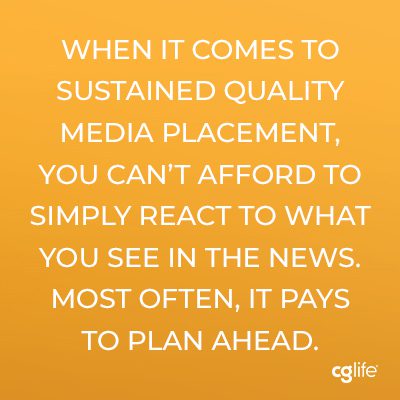Arguably, there has never been a time where looking forward to the upcoming year required a greater need for careful thought and planning to ensure business success. With the world in flux, the science media landscape is extremely noisy, and as a media relations professional, you’re going to have to figure out a way to rise above it all to generate visibility for your company. So, how do set your company up for maximum media coverage over the next year? Start by building an editorial calendar for your organization!
Regardless of whether you’re marketing for life science, healthcare, or any other industry, don’t take the construction of an editorial calendar lightly. It may be tempting to think of it as a low priority project and offload this assignment to an intern or less experienced team member. But in reality, while it may look easy to build an editorial calendar full of potential media opportunities, the calendar is only as valuable as the quality of thought and consideration put into it.
Speaking from my own experience, I can tell you that the set of life science, healthcare, pharma, and biotech trade publications in my world is large and multifaceted. To truly prepare a functional calendar, I must make a concerted effort to make sense of all the publications out there and plan out how best to target them in the upcoming year.
To build a strong editorial calendar, a marketing team has to delve deeply into its company’s goals, as well as the media landscape, to successfully identify publications as valuable candidates for helping you spread your story.
In this blog post, I will explain the importance of an editorial calendar in science marketing and describe the steps involved in building a great one that offers a good return on investment. As you plan your next editorial calendar for the coming year, keep the following ideas in mind.
The Importance of Editorial Calendars
As discussed in my earlier post about how to earn calls from editors, an editor will only be interested in a pitch if the story angle matches the publication’s editorial focus. Science journalists are very smart, and they know exactly what they’re looking for – so you better be ready to provide them what they need. On the flipside, since the technologies and supplies you’re selling have very specific uses and your customer base is relatively narrow, your bosses will only be interested in a media opportunity if it targets people in certain positions within a particular niche. To place a pitch accurately—where you drop the perfect pitch into an editor’s inbox at just the right time—it helps to know when the right opportunities are coming.

This is where an editorial calendar comes in. If built correctly, an editorial calendar helps marketing and public relations professionals keep track of good opportunities to reach out to the appropriate reporter at the right time. It will contain a list of all the publications that not only match the focus of the story you want to tell but also reach your company’s intended audience. With an editorial calendar at your disposal, you won’t have to repeatedly examine publications or their editorial directives every time you want to pitch a story; as such, an editorial calendar can save you loads of time. Without a comprehensive editorial calendar, you’ll find yourself scrambling to reach editors, while trying to generate relevant ideas on the fly. When it comes to sustained quality media placement, you can’t afford to simply react to what you see in the news. Most often, it pays to plan ahead.
Once you build an editorial calendar for your company, it can serve as an ongoing catalog of the media opportunities that will give you the greatest chance of landing valuable placements for your company in the media outlets you pursue.
But how do you find the right publications to include in an editorial calendar? How do you keep your company’s desires and the media’s interests straight?
Collecting the Information You Need
To start constructing an editorial calendar, first communicate with your team about what the next year holds in terms of planned product launches, newly-emphasized applications, and any new target audiences. For example, your biotech company may launch a new product for an industry niche they’ve never operated in before or work to expand the use of their existing technology into additional research fields. Essentially, your job here is to collect the information that allows you to target both your current audience and your new ones. Once you have these conversations with your team and figure all of this out, you then need to develop two lists:
1). Keyword List
In the life sciences and healthcare, your products or services may support a specific process, workflow, or clinical protocol. For an editorial calendar, these elements need to be translated into keywords: words or phrases associated with these applications. The best keywords satisfy two criteria: they 1) match your marketing priorities 2) link your work to themes commonly discussed in the media.
Finding the right keywords is not as complicated as you might think. Typically, the terms you use regularly around the office to describe your products, their applications, and the technologies they employ match up pretty well with established keywords already used in the media; that is, as long as you’re looking at the right publications (we’ll get to that later). At the most basic level, disease names (e.g. “Alzheimer’s disease”), medical specialties (e.g. “neurology”), research tools (e.g. “liquid handlers”), and techniques (e.g. “next-generation sequencing”), will pop up regularly on editorial calendars from relevant publications. The more specific you get (e.g. “APOE4 mutations”), the less likely it is that you’ll find your keyword, but when you do, that opportunity will more closely align with the editor’s needs.
If you’re still not sure what keywords would enable you to find editorial opportunities that your company will fit, spend some time reading content that your company theoretically could have been featured in, and see what words regularly pop up. You can also make use of keyword tools like those from Moz or SEMRush to expand upon the list of keywords you generate, while using organic search volumes to understand how commonly specific keywords are used online.
2). Media List

As mentioned earlier, you will also need to build a media list comprised of media outlets you are interested in receiving coverage from, based on those publications’ circulation, influence, topics they cover, and audience. This media list will mostly comprise of trade magazines (e.g. Genetic Engineering & Biotechnology News, Drug Discovery News, Chemical & Engineering News, or Technology Networks) because publications that are this niche are more likely to produce editorial calendars of their own. Furthermore, if your company’s expertise lies in a specific area of the life sciences, you may want to pursue publications that focus even more narrowly on your target audience. For example, a company that manufactures medical devices may be interested in publications such as Medical Device and Diagnostic Industry News , a contract research organization might pursue Applied Clinical Trials or Outsourcing Pharma , and a drug developer may aim for BioPharm International. To help broaden this list, talk with your team about what they read to stay informed, and don’t ignore smaller outlets. Media placement in science marketing is much more about reaching the right folks than the most folks.
Finding Publications’ Editorial Calendars
Once you have accumulated your keywords and media list, you must look at each individual publication’s editorial calendar to find your keywords.
Almost every life science trade publication has an editorial calendar of their own, which they use to guide their editorial focus over the course of a given year and plan out their own strategy. Typically, they lay out the topics they will be covering month-to-month and make this information available for anyone to review. Usually, you can usually find a publication’s editorial calendar in their media kit. Sometimes you need to email their sales or advertising team. Often, they’ll be very willing to help you because seeking an editorial calendar is commonly the first step towards buying advertising space in a specific issue of a publication.
Building Your Editorial Calendar
So, you’ve collected your media list and keywords, and all the editorial calendars you need from various publications. Now comes the tedious part: building your own, custom editorial calendar. You must scan each publication’s editorial calendar for the keywords on your list. If you find one of your target publications is featuring a topic your client is interested in, copy that information over to your editorial calendar under the appropriate date.
An effective editorial calendar requires an extensive and meticulous search of the editorial calendars from your media list. If you skim too fast and miss relevant topics, you’re going to find yourself several months later reading an article that you thought you should have gotten into, if only you knew about the opportunity. If you spread your net too wide and include topics that only somewhat fit your area of interest, you’re going to waste a lot of time pitching stories to editors that aren’t interested.
After you follow the steps I’ve outlined here, you will have a highly detailed, rich editorial calendar that will guide your media relations strategy for the upcoming year and enable success.
To help you along this process, download CG Life’s editorial calendar template to help you organize your thoughts and plan a winning media strategy.
